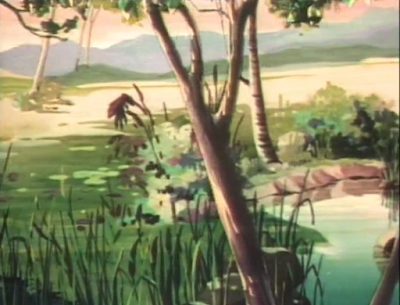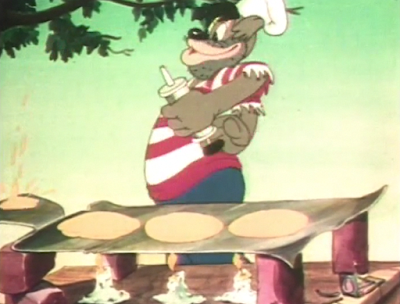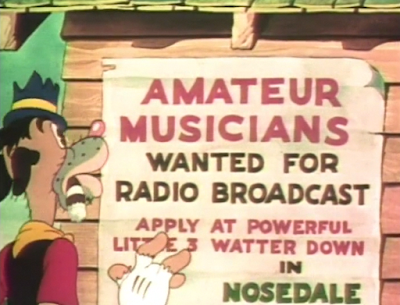Release Date: June 17th, 1939
Series: Merrie Melodies
Director: Ben Hardaway, Cal Dalton
Story: Jack Miller
Animation: Dick Bickenbach
Musical Direction: Carl Stalling
Starring: Pinto Colvig (Hobo Leader), Mel Blanc (Hobo, Informant, Mr. Sneer), The Sportsmen Quartet (Chorus)
At last, Pinto Colvig is given his first major role in a Warner Bros cartoon. Briefly joining the WB crew in between gigs for Disney and Fleischer, Colvig served as both a voice artist and a storyman. Dick Bickenbach is also granted his first animation credit--perhaps most known for his layout work at MGM on the Tom and Jerry series throughout the late '40s through mid '50s, Bickenbach floated from unit to unit, working with the H/D team, Friz Freleng, Frank Tashlin, and Bob McKimson.
Initially named Hobo Heaven, Hobo Gadget Band serves as an inverse to Cal Howard and Cal Dalton's memorable Katnip Kollege: rather than a jovial story about swinging jazz cats, Gadget entails the story of dog faced hoboes coming together and winning the hearts of radio listeners everywhere through their rural rhythm.
As some Hardaway and Dalton efforts do to read as theatrical, Hobo Gadget Band opens with the aid of a rolling, scenic pan. Though the actions of the animals themselves feels relatively inorganic and canned—particularly when a frog spots the camera and leaps into the water in a rather mechanic, slow move—the painting itself is successfully picturesque, sustaining a nice discrepancy between light and dark values. An overlay of trees in the foreground attempt to mimic the Disneyesque strategy of a multi-plane camera pan, a method to deepen a shot’s composition that Tex Avery himself was rather fond of.
Such saccharine environments typically result in an antithetical punchline, which arrives here in the form of the “Hobo Hotel”, a disheveled vagrant’s haven that clearly indicates all rooms are outside. The tonal shift between the hotel and its surroundings is serviceable, though the attempt to be funny through the camera pan speeding up on landing on the hotel falls flat seeing that the shift in speed is hardly noticeable.
Segue to more pans, now occupied by the domicile’s dozing denizens. The camera halting its pan on one particularly prominently lipped indicates that he is the object of the audience’s attention for the time being.
To stress the simplistic, rural methods of living present in the hotel, the hobo is awoken not from the alarm clock ringing on its own, but a woodpecker hammering against the bell. The irony between Ben Hardaway including a red woodpecker in a Warner cartoon, seeing just how involved he was with Woody Woodpecker’s development and character as a whole, writing for and later voicing himself, is duly noted.
A transition in Carl Stalling’s musical choices from “Deep in a Dream” to “Carolina in the Morning” suggests a shift in tone perhaps better than the action on-screen; the belabored yawns and stretches from the hobo do little to feel peppy or amusing. Even if the laborious process of his getting up is the joke, the energy in the filmmaking certainly isn’t present.
At the very least, the hobo opening the curtain to his suspended window and allowing the sun in works thanks to the double exposures sun beam pouring into the “room”. Had the hobo just opened the curtains and basked in the air with no shift in light, the gag would feel twice as corny.
Morning routines often mean showers, which entails a somewhat bloated sequence dedicated to more makeshift props. In this case, the tramp siphons water through a bucket with a baster, squeezes it into a pipe, which is then transferred into a can with holes at the top that dispenses the shower water itself. The makeshift props are fine in themselves, but, like all Hardaway/Dalton efforts, the delivery could have been twice as fast.
While bathing in the shower water would be enough to stress the point about the whimsical lives these hoboes lead, Hardaway of course drags the gag further by making the hobo collect a few spare drops of water on his fingers and thusly wipe his eyes and ears. The ginger, delicate movements of the hobo are carried primarily through Carl Stalling’s gentle, flitting music score rather than the visuals or pacing itself. Once again, as is the norm, the potential is there, but the bloated and uninspired execution make it much more boring and less playful than it should be.
A snap and contemptuous wink of the eye concludes that the tramp has forgotten something as he halts his morning trek.
Enter a broken first aid box hanging from a tree, which serves as a medicine cabinet. A rather needlessly long pause ensures that the audience understands that the effervescent tablets are pivotal to the coming gag.
While the tablets themselves may be branded as a generic “soda fizz”, Pinto Colvig shills for Alka-Seltzer in his signature Goofy voice, repeating the product’s tagline: “Almost forgot my sodium acetyl-salicylate! Just listen to it fizz.” Daffy would hawk the same catchphrase in Scrap Happy Daffy, not burdened by wooden vocal direction as Colvig is here.
With the aid of a conveniently full glass of water on a nearby crate, the tramp drops the tablet in the glass and proceeded to wrestle with the volcanic, carbonated eruptions spawned by the tablets for 25 long seconds.
Perhaps the sequence of the hobo repeatedly being sprayed, jostled, and flung about (peppered with wordless, laborious reaction takes, at one point randomly running in circles, such urgency not reflected in the action nor music) would be bearable if there was a physical end goal in mind. Judging by the shaving equipment in the first aid box, one almost assumes that the Alka Seltzer fizz is a replacement for shaving cream, which would be a mild but politely clever idea. Rather, it merely serves as an excuse for rather bloated and—most criminal of all—boring antics for the sake of antics.
Thankfully, a shot of a train chugging along a nearby hill indicates a shift in structure. Carl Stalling’s musical accompaniment provides the heavy lifting, succinctly mirroring the train’s movements through a circuitous, anticipatory, chuffing rhythm. That the train expels a cloud of smoke on every other beat of music is certainly a welcome touch.
Rather than clamoring to board the train, another hobo (given the spotlight later in the cartoon) opts to seek out the train’s musical potential by playing an accompanying clarinet (that is, a carved stick and a funnel) solo of “Kingdom Coming”.
Instead of expanding upon the soloist's craving for music, with all of the hoboes lending their musical prowess into a big band number that exposes their talents, Hardaway and Dalton instead use this as an excuse for more aimless gags, Stalling’s musical accompaniment serving as the only bridge connecting the activities together. While the song and dance activities of the hoboes are expounded upon later, it does seem awfully misguided to potentially build up to a strong exposition displaying everyone’s talents and instead use it as an opportunity for more corny gags.
Such gags entail a chef cooking himself some fish, the source of the food coming not from the refrigerator, but the pond behind it. Jovial strikes of a frying pan against various body parts are the only musical association found in this sequence in terms of the action at hand. Attempts to mimic the free for all, medley ridden Katnip Kollege are certainly there, but fall flat through a misunderstanding of what made the spontaneity of the aforementioned cartoon work. One guy playing clarinet for 4 seconds and another beating a frying pan in a rhythmic fashion doesn’t necessary make for a substantial song number.
In any case, that the gags of a man scrubbing his laundry (revealed to be full of holes), a barber massaging the hair off his patient, and a chef cooking pancakes on a makeshift griddle with a needlessly dramatic pause as he runs out of room are all mostly timed to Stalling’s musical score is a victory, no matter how small. None of the gags are very funny, and certainly aren’t rescued by good execution. At the very least, needless as the scene is, the cook squirting the pancake batter onto his makeshift griddle is benefitted through appealing poses and varied spacing for Hardaway and Dalton standards. Excessive wrinkle lines and tapered eyes when he frowns suggests the work of Rod Scribner.
Another train arrival, another shift. Thankfully, the comparatively intricate animation of the train rounding the corner and Stalling’s musical shift towards “Corn Pickin’” suggests that the train’s arrival is of more importance than its previous cameo. A close-up shot of the conductor blowing through a mouthpiece into a whistle solidifies its permanence.
That one of the lowest points of the cartoon is derived from a man announcing train arrivals from a makeshift information desk is somewhat reassuring—there is certainly potential for worse to occur. Unfortunately, butchering Mel Blanc’s line deliveries through uninspired, poor vocal direction is felonious. Embracing Hardaway’s fetish for unnecessarily excessive dialogue, the announcer butchers every single destination (“highlights” include “Tusca-loo-soo”, “Al-be-kwer-kee”, and “San Quenti—uh, correction, that’s San Diego”, interruptions like those amusing only to Ben Hardaway and Hardaway alone) with deliberately slow, wooden deliveries that would be lethal if the visuals weren’t occupied with various shots of the tramps turning their heads in interest.
One wishes that the speed in which the hoboes take off for the train was imparted onto the informant’s deliveries. “California, Here I Come” serves as appropriate musical accompaniment—in Stalling’s book, anything else would be criminal.
Indeed, a rather uncharacteristic amount of energy is present in the sequence of the gang boarding the train, sustained by Carl Stalling’s accompaniment. Each tramp uses a rickety slide built on the hillside to slide into an open boxcar, a musical flourish rising to a crescendo for each hobo that slides onto the screen.
Save for one. While the pause is once again slightly too long for appropriate emphasis, a lone pig smacks right into the side of the train, casting signature H/D befuddled blinks towards the camera. With each person, Carl Stalling orchestrates his accompanying slides with a glissando heading up the scale. For the pig, the glissando heads down, a subtle way to separate him from the pack.
Then comes the musical antics that were so absent previously. A brief sequence dedicated to the clarinet player evidently clearing off a crate by smacking his handkerchief and doing little else, emptying the ashes of his cigar and then pulling out his clarinet is a bit misguided and vague in its execution. Nevertheless, the George Gershwinesque tones from his clarinet is unmistakable as he kicks off a dance number set to “The Old Apple Tree”.
As always, the musical accompaniment is peppy, and the drawings of the dogs could certainly fare worse—a close-up of a dog nonchalantly stomping and scuffing his heels is particularly appealing through weighted movement and design, something not always present in the Hardaway and Dalton cartoons. The energy is there, but it could certainly be much stronger than it is, and the animation of the dogs dancing isn’t so much fancy footwork than it is aimless gallivanting. It too feels unconfident and slightly confused in its execution, which can be perilous in instances that require such a visceral energy and pep to them like this one does.
Realizing the boxcars are occupied, the conductor suddenly grows aggressive, braking the train to a halt. Stalling’s shift in musical stylings from jovial to razzing suggests a stronger shift in emotion and intent than the animation itself. The staging all throughout the short suffers at times, with characters dipping off screen with held poses, leaving them out of focus and ruining clarity.
Nevertheless, a somewhat artsy for H/D standards shot of the brakes slowing the train’s wheels is welcome, the closed in, slight up-shot angle elevating the theatrics. The animation in the Hardaway efforts is seldom sophisticated, and while the shot here is a far cry from polished or elaborate, it’s certainly a solid enough juxtaposition to the often floaty, glacial movements and designs of the characters.
Poor staging cuts off a portion of the “HOBO ELIMINATOR” sign in the conductor’s compartment, but a combination of the majority of the type, the angry expression on the conductor as he pulls the lever, and a shot of the train ejecting its passengers through shakes and convulsions certainly inform the gag. Metallic clinks and wheezy yet playful huffs from the train itself exaggerate the expulsion thanks to the brilliant sound artistry of Treg Brown.
With a drumroll, the tramps tumble down a ditch, the camera tracking the movements of the clarinet player as he slams right into the side of a nearby building. Allowing another passenger to tumble down with him, skidding to a premature halt renders the sequence to feel more organic; if the lead hobo was the only one tumbling down the hill, it would feel more mechanical and staged than what is already present.
Nevertheless, in a stroke of good fortune, the shed that the leader tumbles into provides the answer to his hopes, advertising an amateur musician hour for a radio broadcast. A tagline of “apply at powerful little 3 water down in Nosedale” is a not so subtle nod to Uncle Ezra’s Radio Station, a spin-off of the National Barn Dance radio station who also sourced its broadcasts from “the powerful little five water down in Rosendale”. Additionally, Alka-Seltzer was a sponsor of both the Barn Dance and Uncle Ezra’s, tying back to the tramp’s earlier hawking of the same product.
“C’mon, gang!” For once, Hardaway spares us from interminable dialogue as the amateur musicians rise to their feet and take off down the road.
Certain props must admittedly be given for the promptness of the transitions. Rather than highlighting a laborious sequence of the gang signing up at the station or struggling to get in, we instead dissolve to the dog faced president of the station, Mr. Sneer, introducing the “Junk Town Gadget Band”. Indeed, all of the makeshift instruments are present, everyone accounted for in their respective positions. The only priority now is a song number.
An original number sung by Pinto Colvig and The Sportsmen Quartet, the song is very catchy and mercifully free of any Hardawayisms on the vocal front. With Colvig just performing his Goofy voice, even Hardaway knew that butchering such a selling point with quirky interruptions or other arbitrary vocal gimmicks would be wrong.
Most of the gimmicks are saved for the instrumental portion (particularly a Harpo Marx caricature or a dog member aimlessly using glass bottles as an xylophone, asynchronous with the rhythm), but the sequence itself is thankfully straightforward—any cuts are used to demonstrate the radio listeners enjoying the tune from wherever they receive the broadcast. Certainly one of the better song numbers in a Hardaway and Dalton cartoon for that reason alone.




























































.gif)






























No comments:
Post a Comment